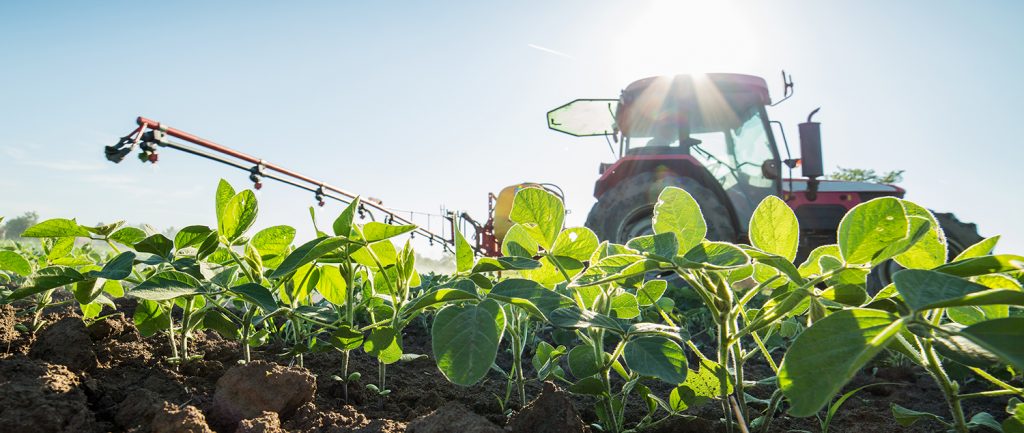This article is sponsored content provided by AgroLiquid
Benefits of Soybean Foliar Fertilizer
The debate of the benefits of foliar fertilizer applications on soybeans has been ongoing for more than 20 years. Some of the benefits to foliar fertilizer applications include quick reaction to deficiency symptoms or low tissue analysis. Foliar feeding enables a bypass of soil issues [such as cold, infertile soil; nutrient fixation, drought; sodium, etc.] or insufficient root growth, which would cause soil-applied fertilizer to not be as readily absorbed. Foliar fertilizer has a relatively low cost, especially if nutrition is added to a foliar crop protection, such as fungicide, plant growth regulators, or herbicide application. It is also possible to target mid-season growth stages with specific nutrients.
Newsletter article:
Benefits of Soybean Foliar Fertilizer
The debate of the benefits of foliar fertilizer applications on soybeans has been ongoing for more than 20 years. Some of the benefits to foliar fertilizer applications include quick reaction to deficiency symptoms or low tissue analysis. Foliar feeding enables a bypass of soil issues [such as cold, infertile soil; nutrient fixation, drought; sodium, etc.] or insufficient root growth, which would cause soil-applied fertilizer to not be as readily absorbed. Foliar fertilizer has a relatively low cost, especially if nutrition is added to a foliar crop protection, such as fungicide, plant growth regulators, or herbicide application. It is also possible to target mid-season growth stages with specific nutrients.
Things To Consider
There are several things to consider when planning a foliar fertilizer program in soybeans. Nutrients must be taken into the plant before the plant can utilize them, whether applied through the soil or as a foliar spray. When applied as a foliar spray, a nutrient must penetrate the leaf surface and be taken into the leaf. Soybean leaves, as well as leaves of most plants, have a waxy layer at the surface known as the cuticle. The cuticle is present on the upper and lower sides of the leaf, but cuticle thickness is usually less on the underside of the leaf. The cuticle and related structures help protect the plant from extremes in temperature, humidity, and pest damage.
Leaves also have stomata, which regulate the exchange of carbon dioxide and water transpiration in the plant. Most of the stomata on soybean leaves are located on the lower side of the leaf. The absorption of nutrient solutions by the leaf surface may occur via the cuticle, cuticular cracks and imperfections, and the stomata.
The soybean plant is affected by several environmental conditions, and that can influence the effectiveness of the fertilizer application. Temperature and relative humidity have the most influence of any environmental conditions. Excessive heat and cold causes stomatal openings to close and restrict nutrient and water movement. Also, plant metabolism slows in these conditions, potentially limiting the ability of the plant to absorb and utilize nutrients. Therefore, it is important to apply foliar nutrition during optimal temperature ranges when plant photosynthesis and respiration are not inhibited. Ideal temperature range for corn and soybeans is 70-85° F.
Application timing is a critical to the potential success of a foliar nutrient treatment. It is important to match the nutrient application to the growth stage of the plant. For example, boron is an important nutrient for flowering and pod establishment in soybeans. A foliar application of boron should be applied no later than early flowering stages (R1 – R3) for the plant to benefit from that application. Nutrients such as potassium and manganese, however, are utilized by soybeans at many growth stages so the plant can benefit from a foliar treatment of those nutrients across a wider application window.
Maximize Efficiency
Plant nutrients can be applied in combination with crop protection products. This saves on application costs and potential mechanical damage from driving through a field. It is important to read and follow the label(s) of all pesticides used in tank mix combination with crop nutrients.
Fertilizer product quality plays an important role in the effectiveness of a foliar nutrient application. Some fertilizer products are very effective as soil applied products but are not effective as foliar sprays. Certain nutrients, especially nitrogen and sulfur, can cause leaf burn and other crop damage if a product not designed for foliar application is used. It is also important to make sure water-soluble granular fertilizers are well mixed in the spray tank to provide adequate nutrition and avoid filter or nozzle plugging.
Minimize Risk
AgroLiquid’s Flavonol Polymer Technology™ makes many of our products effective when applied as foliar sprays. This technology utilizes naturally derived sources that are quickly broken down by plants and used as metabolites in foliar applications, making the nutrients available for the plant to uptake. Many AgroLiquid fertilizer products have been designed to be safe for foliar applications in soybeans, minimizing the risk of crop injury and improving the availability of those nutrients in the plant.
With higher yield goals, foliar feeding may provide optimal results. Timely applications of nutrients can help rectify some nutrient deficiencies, but more important, foliar applications can provide necessary nutrients at times of high demand for plants. Learn more at AgroLiquid.com







